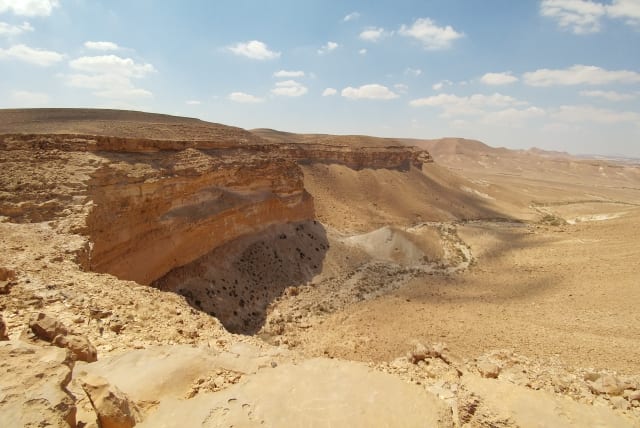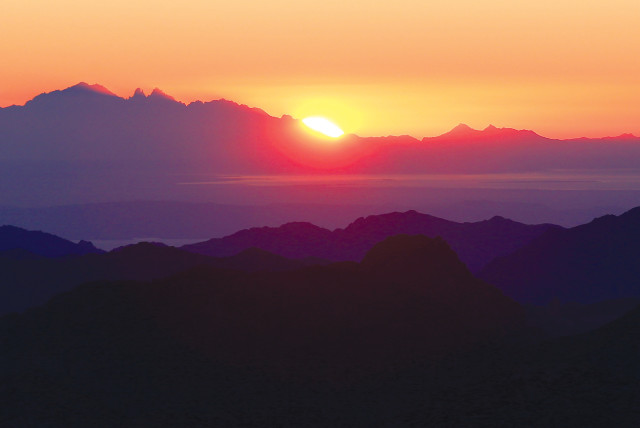Parashat Behar-Behukotai: Higher and higher

Notwithstanding its mysterious whereabouts, Mount Sinai is a mountain. Why is that significant?
The two parshiyot we read this week take place on Mount Sinai. Fittingly, the beginning of the first parasha and the end of the second parasha make reference to that portentous location. The first parasha is called Behar, meaning “on the mountain,” while the second parasha, Behukotai, “my laws,” ends with the phrase “behar Sinai,” on Mount Sinai.
We do not know Mount Sinai’s exact location, just as in the case of Moses’s grave. In both cases, the tradition downplays their locales so as not to turn them into places of veneration, veneration that could border on the idolatrous.
There are a number of mountains that are believed to possibly be the Mount Sinai we read about in the Torah. One of the most intriguing is Mount Karkom, which reaches a height of 847 meters (2,780 feet) above sea level, located in Israel near the Egyptian border in the southwest Negev Desert, with its ancient cultic sites signifying it has an ancient tradition of being a very holy mountain.
Archaeologist Emmanuel Anati says, “We can say that Mount Karkom has been a sacred mountain for millennia... No other known sites of the Sinai Peninsula show such evident, intense and rich traces of cult activity.”
However, many people consider Jabal Musa (2,285 m. [7,497 ft.] high), in the southern Sinai Peninsula, to be Mount Sinai. At its base is St. Catherine’s Monastery, built in the sixth century CE, which encloses a bush thought to be the burning bush encountered by Moses. Cecil B. DeMille filmed the revelation scene for his 1956 movie The Ten Commandments there, with Charlton Heston playing the role of Moses.
Why is Mount Sinai significant?
NOTWITHSTANDING ITS mysterious whereabouts, Mount Sinai is a mountain. Why is that significant? In the spiritual quest, distance and space play their unique roles. Is our experience with God immanent or transcendent?
Dr. Amanda Jenkins explains, “The words ‘transcendent’ and ‘immanent’ often are seen together in theological language. The transcendence of God means that God is outside of humanity’s full experience, perception or grasp. The immanence of God means that he is knowable, perceivable or graspable.”
Mount Sinai can be seen as representing both immanence and transcendence. The top of the mountain is far away, and so in that sense is transcendent, but it is not as far as heaven, and so it is also immanent.
In his brilliant exploration of our relationship to, and role with, the environment, Evan Eisenberg adds insight to the importance of mountains and religious cultures. He writes:
“The two great worldviews I mentioned at the outset belonged to two kinds of civilizations: those of the hilly lands and those of the great river valleys. The first kind typified the Canaanites, the second the Mesopotamians... the hill peoples and the valley peoples had different world-poles. The world-pole is the axis on which the world turns. It is the heart of the world, the source of all life. Nearly every people has a world-pole, but they do not agree on its shape. For the Canaanites, the world-pole was the Mountain: the place sacred to the gods, the font of life-giving water. For the Mesopotamians, it was the Tower: the ziggurat that rose in the midst of the city” (The Ecology of Eden, p. 70).
We note that despite their different cultural orientations, they share the notion that the gods are found by reaching upward. That vertical theology is passed along to, and found in, Judaism from its earliest stages. This is not surprising, as Abraham and Sarah come from, and Jacob, along with Leah, Rachel, Bilhah and Zilpah, spent time in, Mesopotamia (Abraham from Ur [Gen 11:28], Jacob in Padan-aram [Gen 28:6]). In addition, ancient Israel was originally inhabited by the Canaanites (Gen 12:5 - 6).
Responding to this vertex theology, Rabbi Art Green teaches:
“But suppose for a moment that we allowed ourselves to be freed from this upper world-lower world way of thinking.... Some of our greatest philosophers and mystics surely understood that this way of seeing things could well be replaced by one that spoke in terms of ‘inner’ and ‘outer,’ rather than ‘upper’ and ‘lower’.... This journey inward would be one that peels off layer after layer of externals, striving ever for the inward truth, rather than one that consists of climbing rung after rung, reaching ever higher and higher. Spiritual growth, in this metaphor, is a matter of uncovering new depths rather than attaining new heights” (Seek My Face, Speak My Name: A Contemporary Jewish Theology, p. 12).
Perhaps inner and outer can also be understood as an echo of immanent and transcendent, close and distant. In that case, Mount Sinai as a metaphor can stand for the classic upper-lower worldview, with the peak of Mount Sinai perceived as far away, as well as the inner-outer orientation, since most of us never physically climb Mount Sinai; rather, we attempt to spiritually climb it within ourselves. ■
The writer, a Reconstructionist rabbi, is the rabbi emeritus of the Israel Congregation in Manchester Center, Vermont. He teaches at the Arava Institute for Environmental Studies at Kibbutz Ketura and at Bennington College.
Jerusalem Post Store
`; document.getElementById("linkPremium").innerHTML = cont; var divWithLink = document.getElementById("premium-link"); if (divWithLink !== null && divWithLink !== 'undefined') { divWithLink.style.border = "solid 1px #cb0f3e"; divWithLink.style.textAlign = "center"; divWithLink.style.marginBottom = "15px"; divWithLink.style.marginTop = "15px"; divWithLink.style.width = "100%"; divWithLink.style.backgroundColor = "#122952"; divWithLink.style.color = "#ffffff"; divWithLink.style.lineHeight = "1.5"; } } (function (v, i) { });

